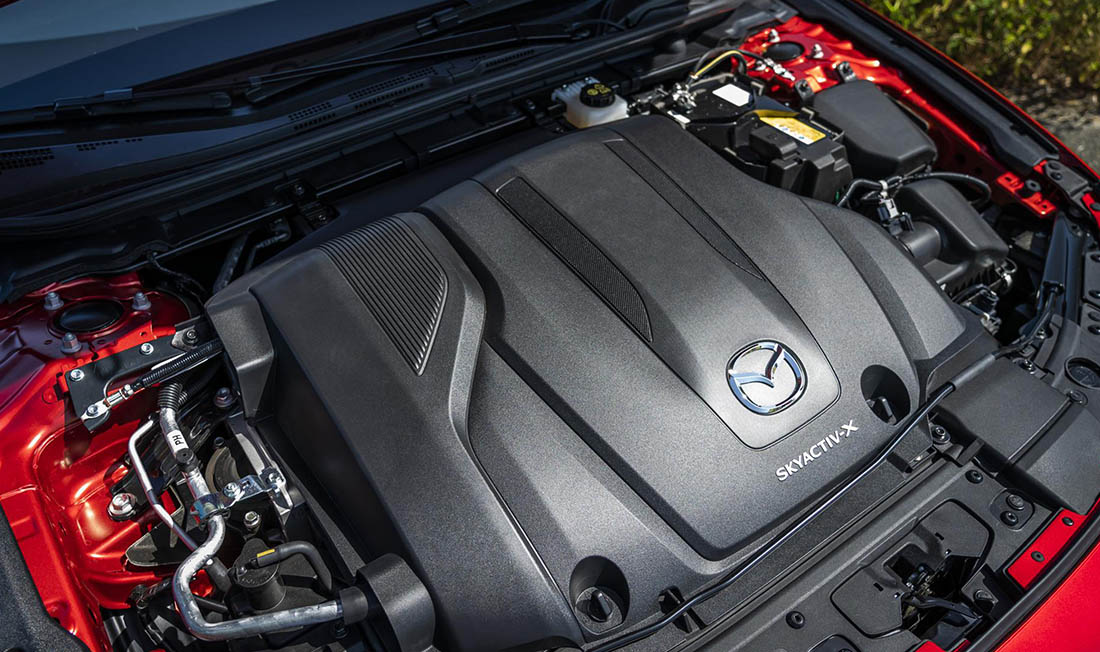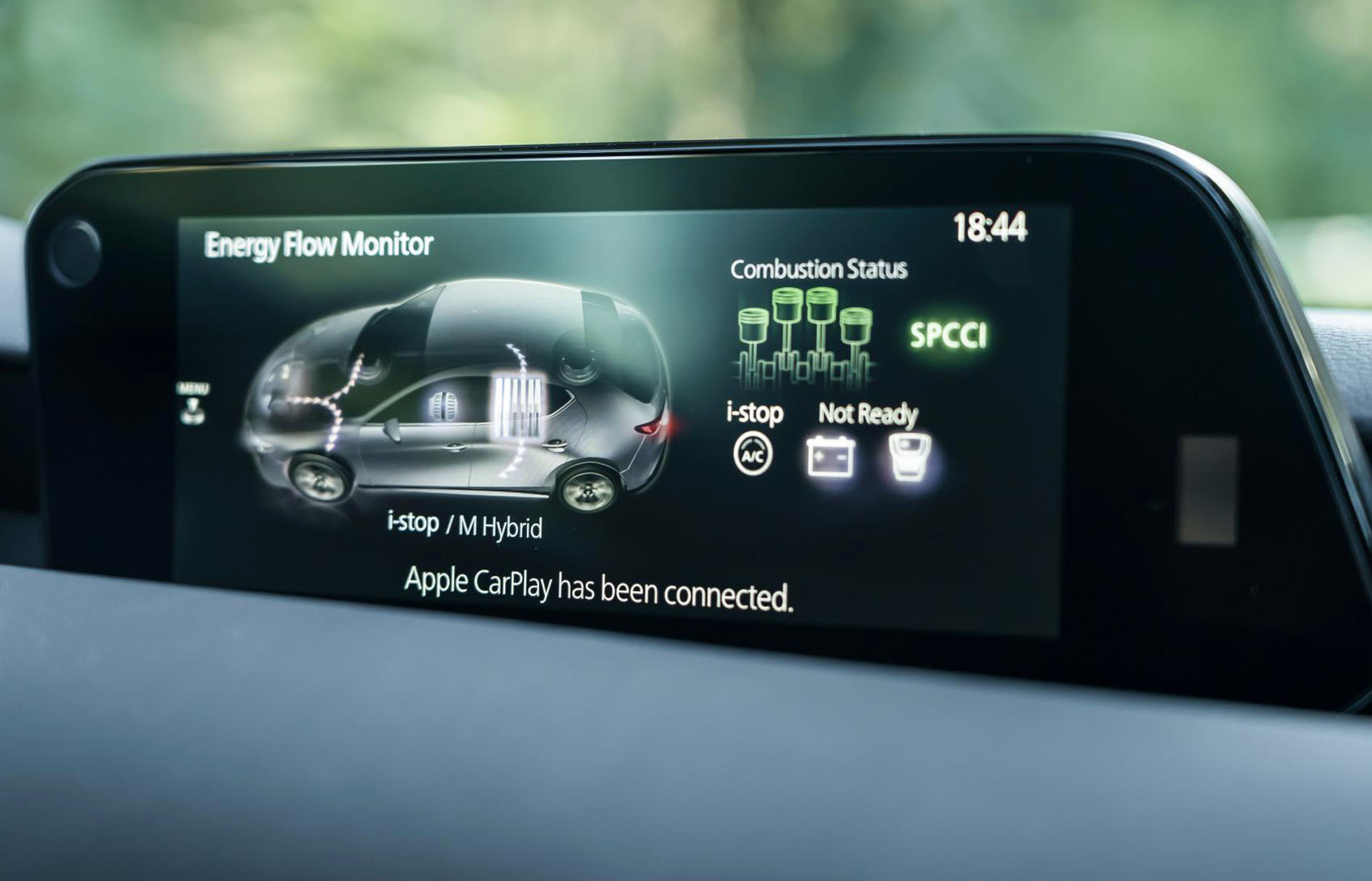Mazda3 review: clever Skyactiv-X engine tested









IT’S HAPPENING.
Yup, Mazda’s 2.0-litre ‘Skyactiv-X’ engine – the world’s first production-ready petrol that uses compression ignition – is finally finished.
At first it’ll only be offered in the Mazda3, with either six-speed manual or six-speed automatic gearboxes and the choice of front- or all-wheel drive. Cars arrive in the UK this October and ought to be priced more or less in-line with the 1.8-litre diesel, which for the moment costs around £1,800 more than the company’s more conventional 2.0-litre naturally-aspirated petrol.
You might need to remind us of the engineering involved…
Erm, ok…but that could take a while.
I’ve got time.
Then we’ll do our best.
Mazda has always done things a bit differently. Most recently, it’s ignored the move towards small-capacity, turbocharged petrol engines – or ‘downsizing’ – and stuck steadfastly to comparatively large-capacity, naturally-aspirated motors.
Downsizing theorises that smaller engines use less fuel, and that you can make up for the inevitable power deficit by adding a turbocharger. Mazda is pretty much the only mainstream car manufacturer that subscribes to ‘rightsizing’, which entails simply using an engine big enough to comfortably power the car to which it’s fitted without the need for forced-induction.

Practically, this is why the Ford Focus is available only with 1.0-litre and 1.5-litre turbo-petrol engines, while the Mazda3 gets only a 2.0-litre N/A petrol. Mazda’s ‘Skyactiv-G’ engine uses an unusually high compression ratio to maintain efficiency. And while it can’t quite match downsized engines in the official tests, in real-world driving it’s broadly as economical.
The ‘Skyactiv-X’ engine is the next step on what Mazda calls its “ceaseless quest to develop the ideal combustion engine”. It is, in essence, another 2.0-litre, four-cylinder petrol engine. Only it borrows from the world of diesel to theoretically give its driver “the best of both worlds” – an engine with the fuel efficiency and low-down torque of a diesel, but also the high-revving character of a petrol. Mazda claims it’s as much as 20 per cent better on fuel than the old Skyactiv-G, and between ten and 30 per cent more torquey depending on rpm.
It does this thanks to something called SPCCI – or ‘Spark Controlled Compression Ignition’ – a system that allows the engine to switch between spark and compression ignition methods as required.
I follow…
Do you, though? Because this is where we start to lose ourselves a bit. But if you insist we shall go on…
In conventional petrol cars, the fuel/air mixture in the cylinder is ignited using a spark from a spark plug. While in diesels no spark is required, for the bang happens when fuel is squirted into a combustion chamber full of hot, compressed air, as the piston nears the end of the compression stroke. The latter is a more efficient process, hence diesel’s traditionally better fuel economy.
Mazda’s SkyActiv-X motor sits somewhere in the middle, and can imperceptibly swap between conventional spark ignition and a form of compression ignition that uses a spark plug to time combustion (to avoid knock). For cold starts and under especially heavy loads (e.g. full throttle), the engine operates as a conventional four-cylinder petrol. The other 80 per cent of time, says Mazda, SPCCI means it can run on a much leaner fuel/air mixture, improving efficiency.
For all you engineers, Mazda describes the process like this: “A series of injections first floods the combustion chamber with a lean mixture of fuel and air during the intake process, then precisely inject a richer zone of atomised fuel directly around the spark plug during compression. Imagine a cherry on a cupcake, where the cherry is the richer zone, and the cake is the lean mixture.
“Because of the high 16.3:1 compression ratio of Skyactiv petrol technology, the first charge is on the verge of spontaneously combusting anyway. To ignite the mixture at the right time, a small injection of atomised fuel directly around the spark plug builds a richer core. When the spark fires, it ignites the local zone of fuel and air. This increases pressure in the combustion chamber to the point where the lean mixture combusts.”

Ok, I think I’ve got it. Now, what’s it like in practice?
Not all that different to Mazda’s normal petrol engine, actually, because you have to drive it in much the same way. It’s not transformative to the character of the car. For all Mazda’s promises of superior low-down response, the Skyactiv-X remains at its core a nat-asp petrol engine (despite the, ahem, supercharger). It’s immediately brawnier than the Skyactiv-G, but to make progress you still have to use many of the available revs and most of the gears. People coming from four-cylinder diesels and turbo petrols will find this a little odd.
They might find the noise odd, too. It starts with the thump of a diesel but settles into the idle of a petrol. Then it goes a bit diesel-y in the mid-range, before turning into a petrol again as you get nearer peak power at 6,000rpm, to which it revs pretty happily. A colleague from another magazine, on the same event, described it so perfectly I’m going to steal his metaphor – in general it does sound like a diesel, but one about 200 metres away. Where the knocks and rattles are still there, but so muffled you seldom notice them. Marginally less refined than a conventional petrol, but leap-years ahead of even the smoothest diesels.
The company claims 175bhp and 224Nm at 3,000rpm, to the Skyactiv-G’s 120bhp and 213Nm at 4,000rpm. A front-wheel drive, manual hatchback on the smaller 16-inch wheel can accelerate from 0-100kph in 8.2 seconds and reach 216kph. But there are more important numbers – official fuel economy and CO2 figures are 51.3mpg and 125g/km of CO2, again for the FWD manual.
We tried both manual and automatic transmissions (the former is excellent, because Mazda. The latter is behind the times and ought to be avoided) on half-hour loops around Frankfurt. The manual yielded just over 40mpg (7.1L/100km), and the auto just under. Not bad, given we weren’t exactly driving with fuel economy in mind and had autobahn stints of over 160kph. Driven normally, your average ought to live in the mid-forties.
It’s impressive how often the engine slips into SPCCI. There’s a display in the infotainment system that tells you what’s going down under the bonnet, and it’s really only when you’re at or near full-throttle or starting from cold that the little SPCCI icon isn’t illuminated, and the engine isn’t burning the super-lean mixture a normal petrol motor could only dream of igniting.









So, should I buy it?
Well… the manual, front-drive Skyactiv-X is without doubt the best Mazda3. While it’s less refined than the petrol, it’s more economical (until we can try them side-by-side in the UK we won’t know just how much more, though) more powerful, promises to be only a little more expensive and signals support of a technology that, once it’s been developed even further, could ensure internal combustion’s survival long into the future. For the first commercial application of this technology the Mazda3 really is very good, but there’s plainly space for it to be refined even further.
Ah yes, the future. Is now really the best time for Mazda to be spending lots of money developing new internal combustion engines?
Valid point. Now cities and countries around the world have started indicating they’ll seek to ban the sales of new, internal-combustion-engined cars in only a few decades’ time, shouldn’t Mazda be turning its attention to full EVs, or at the very least plug-in hybrids?
It is doing those – and we’ll see them soon – but Mazda is a proponent of ‘Well-to-Wheel’ emissions, which takes into account greenhouse gasses generated by electricity production, not just actual driving.
It says with two thirds of global energy production relying on fossil fuels, it believes “regulations placing the emissions of an electric vehicle at zero to be disingenuous”, and that “average CO2 emissions of an EV can be very close to a conventional vehicle depending on the energy mix from which the electricity is made”.
“Thus recognising that electric powertrains do not, in fact, currently satisfy society’s wish for a drastic reduction in greenhouse gas emissions, Mazda is focusing on bettering the real-world emissions of EVs by maximising the efficiency of the internal combustion engine,” it concludes.
Mazda acknowledges that the internal-combustion engine is going to remain the driving force of road transportation for years to come, so it wants to make it as efficient as possible. Makes perfect sense.
Power to it.
- Tom Harrison

